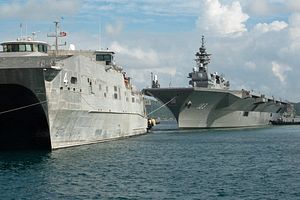It now seems clear that Japan is actively considering the acquisition of F-35B fighters for use on its Izumo-class aircraft carriers. A recent LDP panel report emphasized the need for offensive capabilities, including carrier-based strike aircraft. Although the government has maintained that the purpose of the carriers will remain primarily defensive, it hasn’t escaped notice that the F-35B could transform the Izumos from sea control platforms into potentially formidable strike carriers.
The realization of Japan’s naval aviation potential has required a conjunction of strategic, political, and technological factors. Japan has operated large, flat-decked aviation ships since the beginning of this decade, with the Hyuga class. These ships are roughly equivalent to the light carriers operated by other navies, carriers which in the past have operated AV-8 Harrier fighters. Yet Japan has steadfastly resisted the idea of considering these vessels “aircraft carriers” which inevitably has offensive connotations. But the advent of the F-35B, the world’s first supersonic stealth VSTOL fighter, and the increasing power and reach of China’s navy, have combined to change Japan’s calculus.
It is increasingly likely that Izumo and Kaga will eventually carry F-35Bs; the expansion of China’s carrier fleet makes it even more probable. But what comes next? The bigger issue is what Japan’s next generation of carrier might look like, because more than any other world power, Japan is capable of taking a huge leap in its naval aviation forces. Japan has moved from commissioning a 19,000 ton light carrier in 2009 to a 27,000 ton light carrier in 2015. While there are no obvious, public plans for the next expansion, it’s not difficult to discern a trend line. And experience operating the F-35B from the Izumos might well whet Japan’s appetite for larger carriers, and for more conventional carrier aircraft.
Moreover, Japan has an extraordinary latent maritime capacity. Its economy is considerably larger than those of France, India, or the United Kingdom, all of which have active carrier programs. Japan’s shipbuilding industry in healthy and vibrant, and Japan’s self-defense forces have longstanding relationships with established powers in naval aviation. Moreover, Japan is actively engaged in the acquisition of the world’s most modern carrier-capable aircraft. In short, Japan is a better candidate for developing a modern carrier fleet than almost any nation other than China or the United States, and is competitive with the former.
The obstacles that have prevented the development of a carrier force in the past- constitutional issues, concerns over international opinion, a commitment to pacifism- remain, but are slowly being chipped away. These factors may still have an impact on how Japan approaches its next carrier; nuclear propulsion seems unlikely, and recalcitrance about long-range strike may strengthen the focus on defensive fighters. But Japan can probably justify the construction of larger carriers, and the aircraft they require, based on a plausible interpretation of its self-defense requirements in the face of an increasingly capable People’s Liberation Army-Navy. And if Japan does start moving in this direction, we can expect rapid growth in naval aviation capabilities.

































